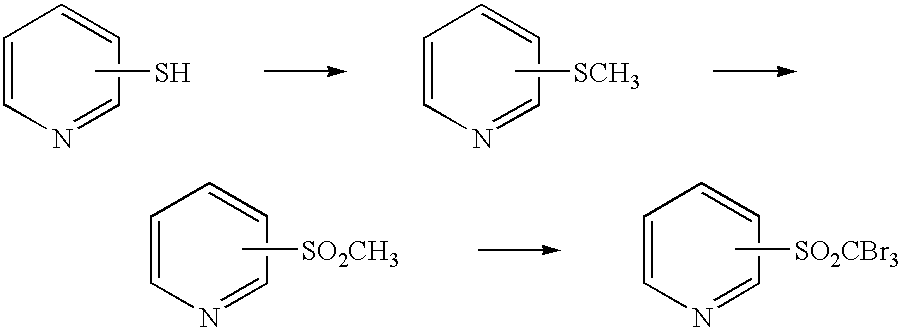Process for preparing tribromomethylsulfonylpyridine
a technology of tribromomethylsulfonylpyridine and process, which is applied in the field of process for preparing tribromomethylsulfonylpyridine, can solve the problems of high amount of sodium hypobromite used, low reaction yield, and high risk of n-oxides, and achieves easy preparation, high yield, and short time
- Summary
- Abstract
- Description
- Claims
- Application Information
AI Technical Summary
Benefits of technology
Problems solved by technology
Method used
Image
Examples
example 2
An aqueous solution consisting of (i) 522.7 g (1.2 mol) of a 27% sodium hypobromite aqueous solution prepared by instilling bromine into a 30% sodium hydroxide aqueous solution and (ii) 5.1 g (0.12 mol) of 95% sodium hydroxide was cooled to 0.degree. C. The 23.8 g of 2-(methylthio)pyridine obtained in Example 1 was instilled into this aqueous solution over 2 hours while keeping the temperature at 0 to 5.degree. C., and stirring was then carried out for 5 hours at 5 to 10.degree. C. The reaction product, which precipitated out as crystals, was filtered, washed with water, and dried, thus obtaining 68.8 g of 2-(tribromomethylsulfonyl)pyridine (purity 99%). The yield relative to the 2- (methylthio)pyridine was 91.9%. The melting point of the 2-(tribromomethylsulfonyl)pyridine obtained was 160 to 161.degree. C.
example 3
An aqueous solution consisting of 11.5 g (0.24 mol) of sodium methanethiolate, 12.6 g (0.3 mol) of 95% sodium hydroxide and 38.3 g of water was instilled into a mixed liquid consisting of 22.7 g (0.20 mol) of 2-chloropyridine, 6.8 g of tetrabutylammonium bromide and 2.3 g of water over 2 hours at a temperature of 80 to 90.degree. C., and stirring was then carried out for 5 hours at 90 to 100.degree. C. The two-phase reaction liquid thus obtained was separated, and 23.0 g of 2-(methylthio)pyridine was obtained as the upper layer. The yield relative to the 2-chloropyridine was 91.9%.
example 4
An aqueous solution consisting of (i) 522.7 g (1.2 mol) of a 27% sodium hypobromite aqueous solution prepared by instilling bromine into a 30% sodium hydroxide aqueous solution and (ii) 11.4 g (0.27 mol) of 95% sodium hydroxide was cooled to 0.degree. C. The 23.0 g of 2-(methylthio)pyridine obtained in Example 3 was instilled into this aqueous solution over 2 hours while keeping the temperature at 0 to 5.degree. C., and stirring was then carried out for 5 hours at 5 to 10.degree. C. The reaction product, which precipitated out as crystals, was filtered, washed with water, and dried, thus obtaining 68.1 g of 2-(tribromomethylsulfonyl)pyridine (purity 99%). The yield relative to the 2-(methylthio)pyridinewas 94.1%. The melting point of the 2-(tribromomethylsulfonyl)pyridine obtained was 160 to 161.degree. C.
PUM
| Property | Measurement | Unit |
|---|---|---|
| reaction temperature | aaaaa | aaaaa |
| reaction temperature | aaaaa | aaaaa |
| reaction temperature | aaaaa | aaaaa |
Abstract
Description
Claims
Application Information
 Login to View More
Login to View More - R&D
- Intellectual Property
- Life Sciences
- Materials
- Tech Scout
- Unparalleled Data Quality
- Higher Quality Content
- 60% Fewer Hallucinations
Browse by: Latest US Patents, China's latest patents, Technical Efficacy Thesaurus, Application Domain, Technology Topic, Popular Technical Reports.
© 2025 PatSnap. All rights reserved.Legal|Privacy policy|Modern Slavery Act Transparency Statement|Sitemap|About US| Contact US: help@patsnap.com

